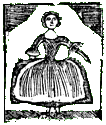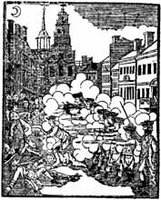Ann Green’s View of the Boston Massacre
 Bartholomew and Abigail Green had a number of children, some of whom lived in the Customs House on King Street with them in 1770. Among those children were two brothers, John and Hammond. (Bartholomew’s mother had been born Hannah Hammond.) I quoted John Green’s account of what he saw at the Boston Massacre last year.
Bartholomew and Abigail Green had a number of children, some of whom lived in the Customs House on King Street with them in 1770. Among those children were two brothers, John and Hammond. (Bartholomew’s mother had been born Hannah Hammond.) I quoted John Green’s account of what he saw at the Boston Massacre last year.
The Greens also had a daughter called Ann or Nancy, and she also witnessed the shooting on 5 March. It was not how she expected her evening to go.
So far as I know, we don’t have any testimony directly from Ann Green, but we can track her through other people’s accounts. Here’s the wigmaker’s apprentice Bartholomew Broaders describing how she and a maid in the family, Elizabeth Avery, asked him to escort them on an errand:
Soon after [eight o’clock] Mr. Green’s maid and his daughter called him out of the shop, and asked him to go to the apothecary’s; and then they with the deponent returned to the custom-house; in going he met his fellow-apprentice [Edward Garrick], and they went & stood upon the custom-house steps, and Mr. Hammond Green came out, saying, come in girls; then the deponent and his fellow apprentice, by the maid’s invitation, went in also…That pleasant visit of the two young barbers with two young maids, chaperoned by one of their brothers, was interrupted by the arrival of a man named Sawny Irving, apparently upset that he had lost his hat in a fight with soldiers. After some discussion Hammond Green showed Irving and the apprentices out.
A few minutes after that, Hammond later testified, “two other boys belonging to Mr. [John] Piemont, came into the kitchen, also my brother John.” Out in the street, as described here, Edward Garrick got into an argument with Pvt. Hugh White, the sentry in front of the Customs House. White clubbed Garrick on the head. Broaders yelled back at the soldier, which started to draw a crowd.
John and Hammond Green went out different doors of the house to see what was going on. John walked further, following the noise. Hammond described coming back to look after his sister:
I went to the steps of the Custom-house door, and Mary Rogers, Eliza. Avery, and Ann Green, came to the door, at the same time, heard a bell ring; upon the people’s crying fire, we all went into the house and I locked the door, saying, we shall know if anybody comes; after that, Thomas Greenwood [another Customs employee] came to the door and I let him in, he said that there was a number of people in the street, I told him if he wanted to see anything to go up stairs, but to take no candle with him; he went up stairs, and the three women aforementioned went with him, and I went and fastened the windows, doors, and gate; I left the light in the kitchen, and was going up stairs, but met Greenwood in the room next to the kitchen, and he said that he would not stay in the house, for he was afraid it would be pulled down…Greenwood left the Customs house, meeting John Green, who was trying unsuccessfully to get back in. The two men went to the army’s guardhouse on the other side of the Town House for help, but found that a squad of soldiers was already on its way to reinforce Pvt. White. And to guard the Customs house itself, in case the mob started to attack the building.
Meanwhile, Ann Green and the two other women were in the upper-floor room, watching the growing violence on the street below.
TOMORROW: What the women saw at the Massacre.



